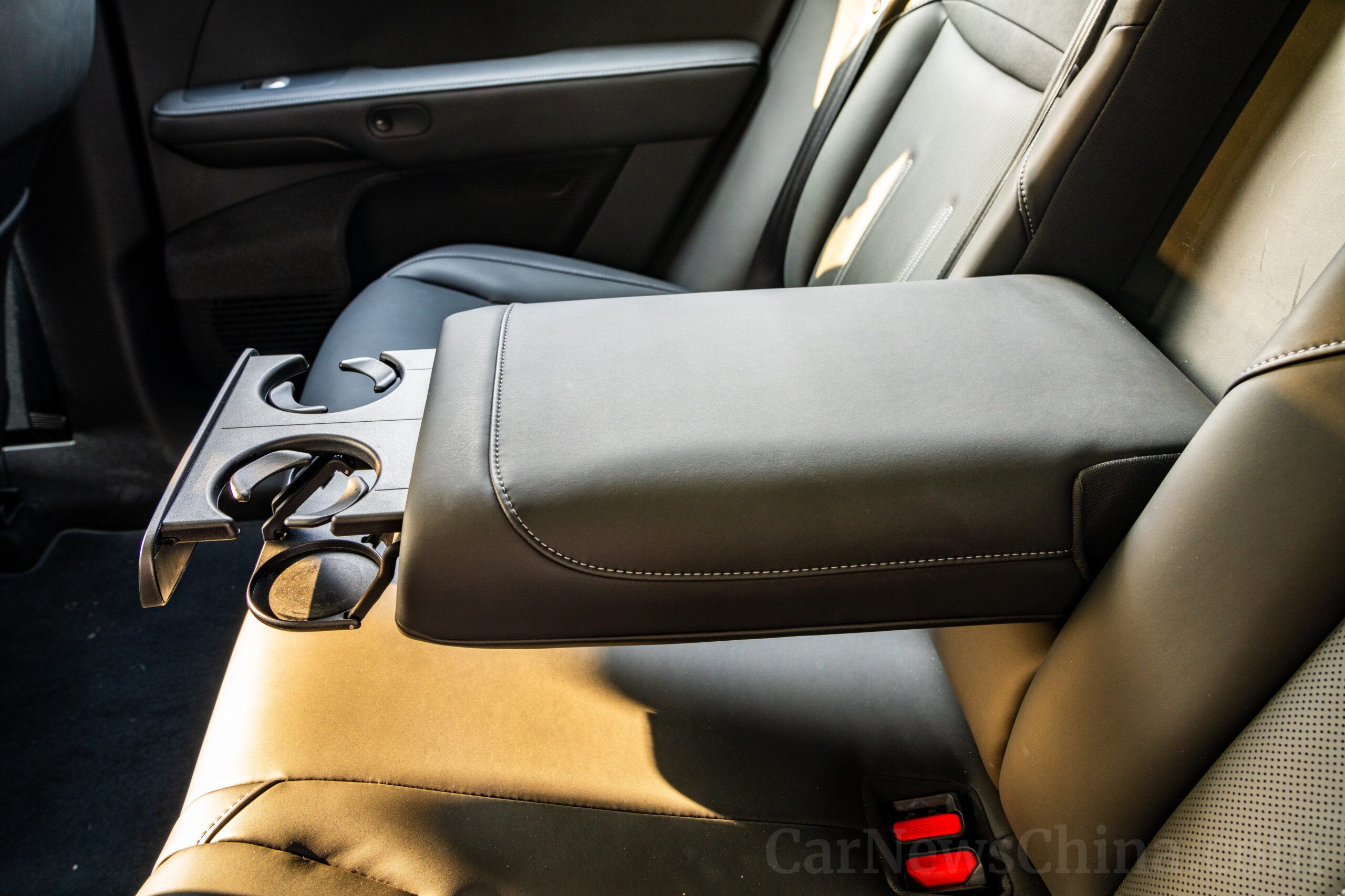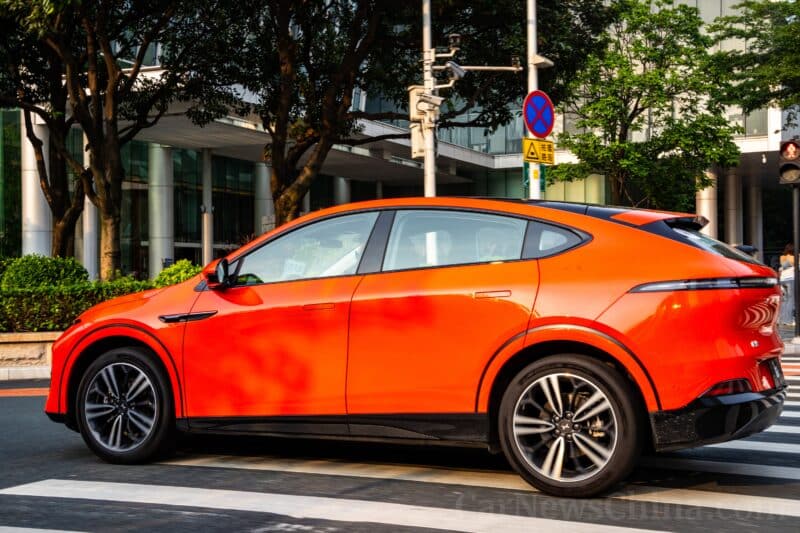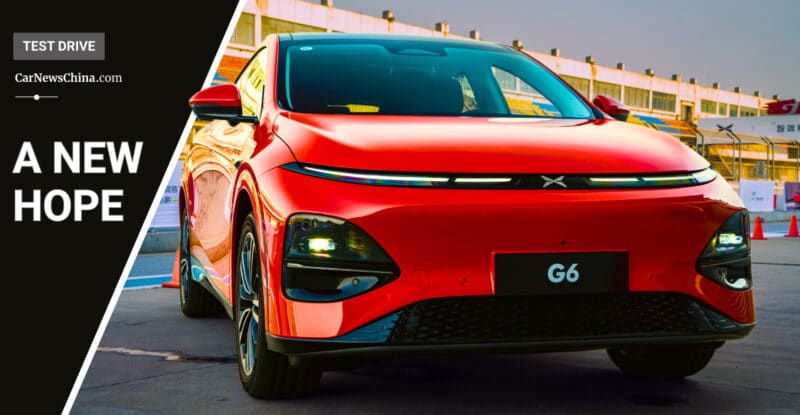Tesla faces increasing competition in China for its Model 3 most notably from the BYD Seal and Nio ET5 (did you read our review?) but also from a raft of other wannabes. Strangely none have dared to tackle the Model Y, until now. XPeng’s G6 is the first serious competitor and for once the Guangzhou based company doesn’t seem to be shying away from the fact, even providing a Model Y for comparison on a test track.

It’s also no secret that XPeng is under pressure. So far the only car that has had reasonable sales is the P7 and the company very much needs the G6 to be a good seller in order to stay in the game. With prices starting from 29,000 USD (209,900 yuans) and ranging up to 38,300 USD (276,900 yuans) for the 700 Performance Max version, as tested, XPeng is certainly coming out with all guns blazing.
Exterior
Although no copycat the G6 takes a very similar approach to the Model Y when it comes to design. Both aren’t really true SUVs but taller crossover type cars optimized for interior space. At first glance it would seem that the car has a classic teardrop shape but the looks are beguiling; black painted strips on the rear roofline make it look as if the G6 has a far more sharply raked roofline than it actually has. This effect is partially destroyed via the upper spoiler. There is a Performance package (1,250 USD) which adds an electrically deployable spoiler lower down, a first on an XPeng, along with 20-inch wheels. The rear is actually quite bulbous and it might actually be better if all models had a permanently deployed spoiler to break up the rear.


Overall the G6 while not ground breaking design wise is fairly distinctive and certainly cuts an imposing profile in what seems to be the signature melting cloud orange paint job (830 USD option), as on our test car. Although it inherits the brand’s robot face design language at the front, one new element is the XPeng badge now breaking up the front light bar.

Despite the chunky appearance the G6 for an EV weighs in relatively lightly ranging from 1995-2100kg. This is in part due to the SEPA2.0 platform and some new technologies employed. XPeng claim the G6 is the first Chinese car to benefit from front and rear aluminum die-casting sections and there is also cell-to-body integration meaning that the battery pack is now load bearing.
Interior & infotainment
Unlike with Nio models, there is very little continuity between the interiors of XPeng cars other than that they all feature at least two screens in some setup or another. The G6 seems to have inherited the center mounted 15-inch infotainment screen from the G9 but unlike its larger sibling it is a single unit rather than a double one. The driver gets a narrow 10-inch instrument screen integrated into the dashboard.

On top of the center console are dual wireless phone charging pads, twin cup holders, and a cubby hole. Underneath the floating console are both type A and C USB chargers. The passenger doesn’t get a glovebox with the area opened up.



A panoramic roof gives the car an airy feel. In the back, the rear occupants get a manually adjustable rake. There is plenty of head room and good leg space as well. The fold down armrest gives two drink holders and on the back of the center console, there are two Type C chargers. Our test car was lacking a parcel shelf in the trunk but there was an electrically operated tailgate and inside the back is a 12V power outlet.


The G6 gets XPeng’s latest Xmart 4.0 operating system which includes the latest version of the company’s Xiao P digital assistant. This has an industry leading ability to recognize and respond to voice commands.
Performance and driving feel
Guangdong International Circuit in Zhaoqing may seem a strange location to first get behind the wheel of the G6 but XPeng seemed keen to compare the car with the Model Y, and more bizarrely the BMW iX3. On the track, there didn’t seem a great deal of difference between the Tesla and XPeng, with the G6 having perhaps a slight edge when it came to handling. With the BMW there was a far more discernable difference and this was likely due to it being only a single rear motor rather then the dual motor setup in the other two cars. While handling might have been slightly better in the BMW it felt overly ICE like and due to the single motor setup was unable to keep pace and also felt harder to bleed off speed.

The question is though, what right minded person is ever going to take the G6 on a track? On road driving consisted of Zhaoqing to Guangzhou and then around central Guangzhou. With both of these tasks, XPeng seemed to want to emphasize the car’s self-driving ability rather than let us actually get a feel for the car.
On the highway XPeng’s new XNGP system performed impeccably. However, the real eye-opener was what happened in Guangzhou under the City NGP portion of the package. Having experienced this earlier in the year on a P7i in Shanghai I had high hopes. However, it turned out to be a tale of two cities with a number of disengagements, poor decisions and interventions required.

Later I drove myself through heavy traffic to the hotel in Guangzhou and the experience was far less stressful than monitoring what the car was up to in the city. Like every other XPeng, the G6 is still lacking a head up display. Supposedly the reasoning behind this is that the self-driving capability is so good it doesn’t need it. This however is a fallacy, especially in the city you are having to look at the central screen to see what the car is up. In contrast on Li cars, you can see all this information in the head up display allowing you to monitor both the real situation and what the car is up to.

The dual motor version Performance Max G6 has a 3.9 seconds acceleration time and the steering is reasonably weighted. As usual, the suspension is more geared up for comfort than dynamics, however XPeng claim the elk test has been achieved at 82 km/h, and certainly on the track the G6 does feel responsive. However, the dual motor setup is only available in one top of the range version, all other versions make do with a single rear wheel motor. The cheaper lithium-iron phosphate battery versions do 0-100 in 6.6 seconds and have a 580km range. With the liquid cooled ternary lithium battery acceleration is boosted to 5.9s and the car achieves a headline range of 755km, the range in the dual-motor version drops to 700km.
Sum up
Another major selling point for the XPeng G6 is the 800V architecture given by the SEPA2.0 platform. Where this really counts is with the time taken to charge. Using XPeng’s own 3C chargers up to 300km of range can be added in 10 minutes. It should be pointed out that the car is very efficient, this is partly due to aerodynamic optimization but also attempts at reducing weight and advantages the 800V architecture brings. In the single-motor, 87.5kWh NCM battery version range is 755km under China’s CLTC standard, a very impressive figure.

If the keen pricing can get people to look at the G6 instead of a Model Y they should be impressed by what they see. XPeng has some of the best tech in the industry such as its control system and evolving self-driving ability.
Verdict
| Power & Drive feeling | 8 |
| Passenger space | 8 |
| Tech & UX | 8 |
| Price quality ratio | 9 |
| The best thing | Very good value for money |
| The worst thing | Variable performance of the city portion of XNGP |
Overall
This car certainly has the ability to give the company a much needed shot in the arm with sales. Such keen pricing should ensure people go to the salesroom to look at what is a distinctive looking car which has good equipment levels underpinned by technologies that are class leading.

Based in Shanghai, Mark Andrews is one of the leading English language authorities in the Chinese auto industry. You can follow him on Twitter.



